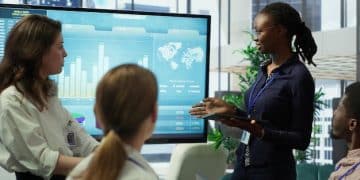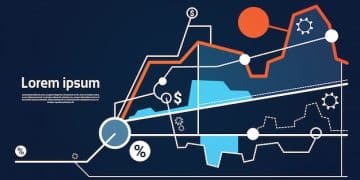Automation’s Impact on Workforce: Prepare Your Business for Future Work

The advent of automation is fundamentally reshaping the global workforce, necessitating proactive strategies from businesses to adapt to new skill demands, evolving job roles, and ethical considerations for a sustainable, human-centric future of work.
The landscape of work is undergoing a profound transformation, driven largely by the accelerating pace of technological innovation. Within this shift, The Impact of Automation on the Workforce: Preparing Your Business for the Future of Work stands as a critical challenge and opportunity. How can organizations navigate the complexities of machine intelligence, robotics, and advanced analytics to not only maintain but enhance productivity and human potential?
Understanding the Automation Revolution
Automation isn’t a new concept, but its current iteration, fueled by artificial intelligence, machine learning, and advanced robotics, is revolutionary. Businesses are increasingly adopting automated systems for tasks ranging from routine data entry to complex analytical processes. This integration promises efficiency gains, cost reductions, and increased precision, yet it also ushers in a period of significant workforce adjustment.
The automation revolution can be understood through several key dimensions. It’s not just about replacing human labor; it’s about redefining the nature of work itself. Understanding these nuances is crucial for any business aiming to thrive in the coming decades.
Historical Context and Evolution
From the industrial revolution’s mechanical looms to today’s intelligent algorithms, automation has always been a driver of change. Early automation focused on routine, repetitive physical tasks. Now, it extends to cognitive tasks, impacting white-collar professions. This evolution means that job roles once considered safe are now subject to re-evaluation, demanding a new set of skills from the workforce.
The pace of change is also unprecedented. What took decades to unfold in past industrial shifts now happens in years, or even months, requiring businesses to be exceptionally agile in their response and planning.
Key Technologies Driving Automation
Several cutting-edge technologies are at the forefront of this automation surge. Each plays a distinct role in shaping the capabilities and reach of automated systems, from enhancing manufacturing floors to optimizing customer service interactions.
- Artificial Intelligence (AI): Algorithms enabling machines to simulate human intelligence, learning, problem-solving, and decision-making.
- Machine Learning (ML): A subset of AI that allows systems to learn from data without explicit programming, improving performance over time.
- Robotics Process Automation (RPA): Software bots designed to automate repetitive, rule-based digital tasks, often mimicking human interaction with systems.
- Advanced Robotics: Physical robots capable of complex movements and interactions, increasingly equipped with AI for adaptability.
The convergence of these technologies amplifies their individual impacts, creating powerful automation solutions that can overhaul entire business operations. Recognizing their potential and limitations is the first step in strategic planning.
Understanding the current state of automation technologies and their historical trajectory provides a vital framework for comprehending its imminent impact. Businesses must move beyond simply acknowledging the technology to truly internalizing its implications for their operations and workforce.
Transformative Effects on the Workforce
The transformative effects of automation on the workforce are multifaceted, extending far beyond simple job displacement. While some roles may indeed become obsolete, many others will be augmented, new ones created, and the skills required for nearly all jobs will evolve. This complex dynamic demands a strategic and empathetic approach from businesses.
Examining these effects helps businesses prepare by anticipating future needs and challenges, fostering a flexible and adaptable organizational culture.
Job Displacement and Creation
One of the most immediate concerns regarding automation is job displacement. Routine, predictable tasks, whether manual or cognitive, are highly susceptible to automation. This includes roles in manufacturing, data entry, administrative support, and even certain aspects of accounting and legal services.
However, automation concurrently creates new jobs, often in areas directly supporting the technology itself, such as AI developers, robotics engineers, and data scientists. It also generates demand for roles that leverage uniquely human skills, like creativity, critical thinking, emotional intelligence, and complex problem-solving.
- Displaced Roles: Assembly line workers, data entry clerks, telemarketers.
- Augmented Roles: Doctors (AI-assisted diagnosis), financial analysts (ML-driven insights), customer service agents (chatbot support).
- New Roles: AI ethicists, robot maintenance technicians, human-robot interaction designers.
The net effect on employment is complex and varies by industry and region. Businesses must analyze their specific context to understand potential impacts and plan accordingly.
Shifting Skill Requirements
As automation handles more routine tasks, the demand for “human” skills will intensify. The future workforce will require a stronger emphasis on soft skills and competencies that machines cannot easily replicate. This shift necessitates a significant focus on upskilling and reskilling initiatives.
Beyond traditional hard skills, the ability to adapt, learn continuously, and collaborate effectively with AI will become paramount for employees across all levels. This represents a fundamental change in the educational and training priorities for businesses and individuals alike.
Augmented Work and Human-AI Collaboration
Perhaps the most prevalent outcome of automation will be the augmentation of human work. Instead of fully replacing humans, automated systems often work alongside them, offloading mundane tasks and providing data-driven insights. This allows human workers to focus on higher-value activities that require judgment, creativity, and interpersonal skills.
For instance, a human resources professional might use AI to screen resumes, freeing them to focus on engaging with top candidates and developing talent programs. This collaboration streamlines processes and enhances overall productivity, redefining existing job descriptions and creating new efficiencies.
The transformation of the workforce by automation is not a linear path but a dynamic interplay of challenges and opportunities. Businesses that proactively address these shifts, investing in their human capital and fostering a culture of continuous learning, will be better positioned to harness the full potential of these emerging technologies.
Strategic Preparedness for Businesses
Strategic preparedness is crucial for businesses navigating the evolving landscape shaped by automation. Simply reacting to changes is insufficient; a proactive, forward-looking approach is essential for long-term viability and competitive advantage. This involves a multi-pronged strategy encompassing talent, technology, and organizational culture.
Workforce Reskilling and Upskilling Initiatives
The most vital aspect of preparing for the automated future is investing in human capital. Businesses must proactively identify the skills that will be in demand and provide pathways for their existing workforce to acquire them. This mitigates potential job displacement and transforms employees into assets for the new economy.
Effective reskilling and upskilling initiatives can take several forms:
- Internal Training Programs: Developing bespoke courses focusing on data analytics, AI literacy, and advanced digital tools.
- Partnerships with Educational Institutions: Collaborating with universities and vocational schools to create tailored curricula.
- Online Learning Platforms: Subsidizing or providing access to platforms like Coursera, edX, or LinkedIn Learning for continuous professional development.
- Mentorship and Apprenticeships: Creating opportunities for hands-on learning and skill transfer within the organization.
The goal is to foster a culture of continuous learning, where employees are empowered to evolve alongside technological advancements. This not only prepares them for new roles but also boosts morale and retention, demonstrating a commitment to their growth.
Redesigning Job Roles and Organizational Structures
Automation will inevitably lead to a redefinition of job roles. Businesses must undertake a thorough analysis of existing positions to identify which tasks can be automated and how the remaining human tasks can be redesigned to create more meaningful and productive roles. This isn’t just about efficiency; it’s about optimizing the human-machine collaboration.
Organizational structures may also need to become more agile, fostering cross-functional teams that combine human expertise with AI tools. Hierarchy might flatten as decision-making becomes more data-driven and distributed. Embracing flexibility in how work is organized will be a key differentiator for successful businesses.

Investing in Human-Centric Technologies
While automation often conjures images of machines replacing humans, a smart strategy involves investing in technologies that augment human capabilities rather than solely substituting them. These human-centric technologies empower employees, making them more efficient, informed, and productive.
Examples include:
- Collaborative Robots (Cobots): Robots designed to work safely alongside humans in shared workspaces.
- AI-Powered Decision Support Systems: Tools that provide insights and recommendations to human decision-makers.
- Augmented Reality/Virtual Reality for Training: Immersive technologies to simulate complex tasks and enhance learning.
- Advanced Communication and Collaboration Platforms: Tools that streamline teamwork and knowledge sharing.
The focus should be on how technology can enhance the human experience at work, allowing employees to leverage their unique skills more effectively and focus on tasks requiring creativity, empathy, and complex problem-solving. This strategic investment in technology is paramount for future success.
By prioritizing reskilling, redesigning roles, and investing in human-centric technologies, businesses can transform the challenge of automation into a powerful engine for growth and innovation. This holistic approach ensures that human capital remains at the heart of future business operations.
Navigating Ethical and Societal Implications
Beyond the operational and strategic shifts, preparing for the future of work also means navigating the complex ethical and societal implications of widespread automation. Businesses have a growing responsibility to consider the broader impact of their technological choices on employees, communities, and society at large.
Addressing these issues proactively fosters trust, enhances corporate reputation, and can prevent future regulatory challenges.
Ensuring Ethical AI and Fair Automation Practices
The rise of AI brings with it significant ethical considerations. Algorithms can perpetuate or even amplify existing societal biases if not carefully designed and monitored. Issues of privacy, data security, and accountability in automated decision-making are paramount.
Businesses must establish clear ethical guidelines for the development and deployment of AI and automation systems. This includes:
- Bias Detection and Mitigation: Regularly auditing AI systems for unfair biases in their outputs.
- Transparency: Ensuring that the logic behind automated decisions can be understood and explained.
- Accountability: Defining clear lines of responsibility for automated system errors or negative impacts.
- Privacy Safeguards: Implementing robust measures to protect user data processed by AI.
Adopting a “responsible AI” framework is not just an ethical imperative but also a business necessity, building trust with customers and employees.
Addressing Job Security and Social Safety Nets
The potential for widespread job displacement due to automation raises profound questions about economic security and social welfare. While new jobs will emerge, the transition period can be difficult for individuals whose skills become obsolete. Businesses cannot ignore these broader societal impacts.
While primary responsibility for social safety nets often lies with governments, corporations can contribute by:
- Phased Automation: Implementing automation gradually to allow time for workforce retraining and adjustment.
- Internal Mobility Programs: Actively helping displaced employees transition into other roles within the company.
- Advocating for Worker Training Programs: Supporting public policies that invest in skills development and unemployment support.
- Considering Alternative Employment Models: Exploring options like reduced workweeks or shared work programs to manage transitions.
A compassionate and considered approach to job security fosters a more stable workforce and contributes positively to societal well-being, ultimately benefiting the business ecosystem.
The Role of Government and Policy Makers
Businesses operate within a broader regulatory environment, and governments have a crucial role in shaping the future of work in an automated age. Policies can either facilitate or hinder adaptation to technological change. Collaboration between the private sector, academia, and government is essential to create effective frameworks.
Areas where policy intervention is key include:
- Education Reform: Aligning educational curricula with future skill demands.
- Labor Laws: Adapting regulations to new forms of work and gig economies.
- Data Governance: Establishing clear rules for data privacy and AI accountability.
- Investment Incentives: Encouraging R&D in AI and automation while also promoting workforce development.
For businesses, staying informed about evolving policy discussions and actively engaging in dialogue with policymakers is vital. This proactive involvement can help shape a regulatory environment that supports both innovation and societal welfare, creating a balanced approach to automation’s impact.
Navigating the ethical and societal dimensions of automation requires foresight, empathy, and a commitment to responsible innovation. Businesses that embrace these responsibilities will not only mitigate risks but also build a more resilient and equitable future of work.
Future-Proofing Your Business: Beyond Automation
Future-proofing a business extends beyond merely reacting to automation. It involves cultivating an organizational culture of agility, continuous innovation, and human-centricity that can anticipate and adapt to a constantly evolving landscape. This holistic approach ensures resilience and sustained growth in an unpredictable world.
True future-proofing builds a foundation that is adaptable to myriad disruptive forces, not just automation.
Fostering a Culture of Continuous Learning and Adaptability
A business’s greatest asset in an era of rapid change is its ability to learn and adapt. This needs to be ingrained in the organizational culture, from leadership down to every employee. It’s about empowering individuals to embrace new skills, experiment, and learn from failures without fear.
Practical steps to cultivate this culture include:
- Leadership Buy-in: Leaders must visibly champion learning and demonstrate adaptability themselves.
- Resource Allocation: Dedicating time, budget, and access to learning resources for employees.
- Psychological Safety: Creating an environment where employees feel safe to try new things and ask questions.
- Feedback Loops: Implementing regular feedback mechanisms to identify skill gaps and learning needs quickly.
Such a culture transforms learning from a reactive necessity into a proactive competitive advantage, enabling the workforce to stay relevant and engaged.
Emphasizing Human Skills: Creativity, Critical Thinking, Empathy
As machines become more capable of performing routine and analytical tasks, the value of uniquely human capabilities significantly increases. Businesses must actively seek to cultivate and leverage skills that automation cannot replicate. These “soft skills” are what truly differentiate human workers.
Focusing on these areas means designing roles and fostering environments where:
- Creativity is encouraged for innovation and problem-solving beyond defined parameters.
- Critical thinking enables complex decision-making and strategic analysis, especially when navigating ambiguous situations.
- Empathy guides customer interactions, team collaboration, and ethical considerations, building strong relationships and trust.
These human competencies become the core drivers of competitive advantage in an increasingly automated world, allowing businesses to explore new avenues for growth and service delivery.

Building Resilient Supply Chains and Operations
While directly related to automation’s impact on the workforce, future-proofing also involves building operational resilience. This means diversifying supply chains, investing in robust cybersecurity measures, and implementing flexible production processes. Automation can play a role here, too, by creating more efficient and adaptable systems.
A resilient operation can better withstand economic shocks, geopolitical disruptions, and unforeseen technological changes. It ensures that the business can maintain continuity of service and production, protecting both its revenue streams and its workforce stability.
Ultimately, future-proofing is a continuous journey. It requires a strategic vision that looks beyond immediate technological trends to the fundamental human elements of work, fostering an adaptable, innovative, and ethically grounded organization prepared for any challenge.
Case Studies and Best Practices
Examining real-world examples and best practices provides tangible insights into how businesses are successfully navigating the impact of automation on their workforce. These case studies highlight diverse approaches, from large-scale corporate transformations to focused initiatives aimed at specific challenges.
Learning from successful implementations can inspire and guide other businesses in their own strategic planning.
Companies Leading the Way in Workforce Adaptation
Several companies stand out for their proactive and thoughtful approach to integrating automation while supporting their employees. Their strategies often involve significant investment in training and a re-evaluation of how work is structured.
- Amazon: While known for extensive automation in its warehouses, Amazon has also invested heavily in upskilling programs for its employees. Their “Career Choice” program prepaid 95% of tuition for employees to pursue in-demand fields, demonstrating a commitment to worker transition.
- Siemens: This industrial giant has embraced digital transformation, including automation in manufacturing. Simultaneously, Siemens has emphasized continuous learning for its workforce, creating internal academies and providing access to digital learning platforms to ensure employees’ skills remain relevant.
- Walmart: Facing automation in store operations and logistics, Walmart has launched extensive workforce development initiatives. They’ve focused on training associates for higher-skilled, customer-facing roles and for managing new in-store technologies, converting the threat of job displacement into an opportunity for skill enhancement.
These examples illustrate that successful automation integration often involves proactive investment in human capital, recognizing that people remain the core asset of any enterprise.
Key Success Factors for Implementing Automation Ethically
The successful and ethical implementation of automation is not solely about technology; it’s about people, process, and purpose. Certain key factors consistently emerge in best practice scenarios.
These factors ensure that automation benefits both the business and its workforce, fostering a sustainable transition:
- Clear Communication: Being transparent with employees about automation plans and potential impacts.
- Employee Involvement: Engaging employees in the design and implementation of automated systems, leveraging their domain expertise.
- Proactive Training: Providing ample opportunities for reskilling and upskilling well in advance of technological changes.
- Focus on Augmentation: Prioritizing automation that enhances human capabilities rather than simply replaces them.
- Strong Leadership: Leaders who champion the transformation and invest in their people are crucial for successful adoption.
By adhering to these principles, businesses can build trust, minimize resistance, and maximize the synergy between human and artificial intelligence, leading to more robust and ethical outcomes for everyone involved.
These case studies and best practices underscore a fundamental truth: automation, when managed strategically and ethically, can be a powerful force for positive change. It requires foresight, an investment in people, and a commitment to shared prosperity. Businesses that embrace these lessons are better situated to thrive in the complex future of work.
Preparing for the Post-Automation Era Workforce
As the initial waves of automation mature, businesses must begin to prepare for a “post-automation era” workforce. This future envisions a deeper integration of human and machine intelligence, moving beyond basic automation to a symbiotic relationship where cognitive load is shared, and human creativity is amplified. It requires looking several steps ahead.
This forward-looking perspective focuses on sustained innovation and adaptability.
Reimagining Work-Life Balance and Well-being
In a highly automated world, the demands on human workers will shift. While repetitive tasks may vanish, the cognitive intensity of overseeing automated systems, interpreting complex data, and engaging in high-level problem-solving could increase. Businesses must consider how to maintain employee well-being and foster a sustainable work-life balance.
This could involve:
- Flexible Work Arrangements: Leveraging technology to support remote work and flexible hours.
- Focus on Meaningful Work: Designing roles that provide purpose and intellectual challenge, reducing burnout from mundane activities.
- Mental Health Support: Providing resources for employee mental well-being, recognizing the potential for new forms of work-related stress.
- Continuous Skill Refresh: Integrating learning into daily work to prevent skill obsolescence and reduce performance anxiety.
A workforce that is well-balanced and supported will be more productive, innovative, and resilient in the face of ongoing technological change.
The Rise of the Hybrid Workforce and Augmented Intelligence
The future workforce will increasingly be a hybrid one, composed of human employees, AI systems, and robotic collaborators, all working in concert. The concept of “augmented intelligence” will become central, where AI’s primary purpose is to enhance human cognitive abilities rather than to replace them entirely. This symbiotic relationship reshapes tasks and workflows.
Businesses will need to focus on:
- Seamless Integration: Designing systems where humans and AI interact intuitively and efficiently.
- Shared Goals: Aligning the objectives of human and automated agents toward common business outcomes.
- Trust Building: Cultivating trust between human workers and AI systems through transparency and reliability.
- New Leadership Styles: Leaders who can effectively manage and motivate diverse teams of human and non-human intelligence.
This hybrid model offers unprecedented opportunities for efficiency and innovation, demanding new approaches to management and collaboration, ensuring smooth human-AI interaction is paramount for performance and employee acceptance.
Preparing for Unforeseen Disruption and Continuous Evolution
The lessons learned from automation’s impact highlight one undeniable truth: disruption is constant. Businesses must build systems and cultures that are inherently adaptable to unforeseen technological advances and market shifts. The future of work will not be a static destination but a perpetual state of evolution.
Key elements for preparing for continuous evolution include:
- Scenario Planning: Regularly envisioning different future states and developing adaptive strategies.
- Experimentation and Prototyping: Embracing a mindset of testing new ideas and technologies on a small scale.
- Cross-Industry Learning: Observing trends and innovations in diverse sectors to identify transferable insights.
- Agile Methodologies: Adopting flexible frameworks for project management and organizational response.
Ultimately, preparing for the post-automation era requires not just technical readiness but profound organizational agility and a deep commitment to human potential, fostering an environment where innovation thrives through constant learning and adaptation.
| Key Area | Brief Description |
|---|---|
| 🔄 Workforce Adaptation | Focus on reskilling and upskilling to match evolving job roles and skill demands. |
| 🤝 Human-AI Collaboration | Integrate automation to augment human capabilities, fostering hybrid work models. |
| ⚖️ Ethical Implementation | Develop clear ethical guidelines for AI, ensuring fairness, transparency, and accountability. |
| 🌱 Continuous Learning Culture | Cultivate an organizational environment that promotes ongoing skill development and adaptability. |
Frequently Asked Questions about Automation’s Workforce Impact
▼
Automation will likely redefine many job roles by taking over repetitive tasks. This frees human employees to focus on analytical, creative, and interpersonal functions. You should conduct an audit of current tasks to identify those ripe for automation, and then redesign existing roles to emphasize higher-value, uniquely human skills.
▼
The most effective strategy is a blend of internal training programs tailored to specific company needs, partnerships with external educational providers, and access to online learning platforms. Focusing on skills like data literacy, critical thinking, problem-solving, and adaptability will be key for long-term viability.
▼
While some jobs, especially those with highly repetitive tasks, may be displaced, automation is also a significant creator of new jobs. These new roles often involve developing, managing, and interacting with automated systems, alongside positions that leverage uniquely human skills. The net effect is a transformation rather than a simple reduction.
▼
Ethical automation requires proactive measures. This includes establishing clear guidelines for AI use, regularly auditing algorithms for bias, ensuring transparency in automated decision-making processes, and defining clear lines of accountability for any issues. Prioritizing human dignity and fairness in design and deployment is crucial for trust.
▼
As automation handles routine tasks, skills like creativity, critical thinking, complex problem-solving, emotional intelligence, and interpersonal communication will become increasingly valuable. The ability to collaborate effectively with AI, interpret data-driven insights, and adapt to continuous change will also be highly sought after in the future workforce.
Conclusion
The impact of automation on the workforce is undeniably profound, reshaping the contours of industries and the nature of work itself. For businesses, this is not merely a technological challenge but a strategic imperative that demands foresight, agility, and a deeply human-centric approach. By proactively investing in workforce upskilling, thoughtfully redesigning job roles, and fostering a culture of continuous learning, organizations can transform the perceived threat of automation into an unparalleled opportunity for innovation and sustainable growth. The future belongs to those who view automation not as a replacement for human potential, but as a powerful amplifier of it, steering towards a collaborative future where human ingenuity and technological prowess symbiotically drive progress.





